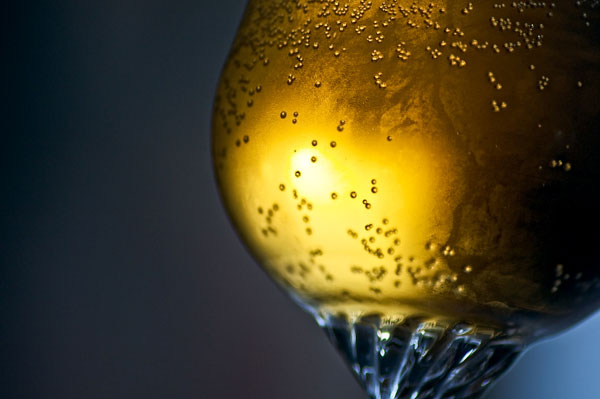July 4: A Beer Drinker’s Guide to Hops
Story by Matt Young. Photo by Charlie. Read more in our Wine & Beer Series.
Cary, NC – Beer might just be the great Fourth of July beverage. Millions and millions of cans, bottles, glasses and cups will be consumed next Wednesday. But how to explain the difference in taste between a Budweiser and a Duvel Special Edition Triple? Just in time for Independence Day, here’s A Beer Drinker’s Guide to Hops.
I’m a Hophead
I love the smell of lupulin in the morning. I’m a hophead.
I drink hoppy commercial craft beers and ales 75% of the time. I brew my own India Pale Ales. There’s hops growing in my Cary back yard. I sometimes buy hops – by the pound.
A Hops Primer – The Bitter Truth
Hops (Humulus lupulus) grows on bines, from rhizomes. Bines are sturdy vines, that grow 20 or more feet high every year and die to the ground in the winter. Hop rhizomes look like thick roots and the hops bines sprout from its nodes. The hops used in brewing look like little pine cones, about the size of a thumb and are soft, yellow-green and covered with resin. And they smell amazing. To me. Not to everyone, so I have found.
Hops add flavor to beer and have the added benefit, that was exploited hundreds of years ago, of helping beer resist spoilage. The bitterness of hops is measured in Alpha units. The measurement of how hoppy a beer is, is measured in IBUs (International Bitterness Units).
Hopstory 101
Conventional wisdom is that hops were first cultivated in Germany over 1000 years ago. Hops that are used in American craft brews and by home brewers are largely from England and Germany (often reverently called “noble hops”) and the United States. Notably, hop cultivation has become big business in the U.S. over the past couple decades in the Northwest.
My favorite varieties are indeed from the good ol’ USA.
Types
There are two basic categories of hops in used by brewers. “Bittering hops” are added earlier in the kettle and are higher in bitterness (Alpha acids) . “Aroma hops” are often added to the kettle later in the brewing process and are lower in acidity. Sometimes beers are “dry-hopped”, meaning the hops are added to the unfermented, cooled beer wort right after the boil.
Different types of hops are added at different times during the brewing process to add complexity, bitterness, flavor and aroma.
Aroma and Taste of Commonly Used Hops
Some people taste wine (and then SPIT IT OUT – LOL) and look wistfully into the air while describing the flavor and aroma and pontificate about grape varieties and vintages. You can do the same with beer, you know.
But try not to act like a tool.
To get you started here’s what my favorite hop varieties taste and smell like. To me. And some of the beers you may have tasted them in, thanks to Taste Your Beer.
Types of Hops
- Saaz – The famous Czech hop in the original pilsener – Pilsner Urquell. Used for aroma, very unique, not intimidating, earthy. Low acid.
- Fuggles – From England. Controversial conversation subject with home brewers, many hate it. I love it. Woody, not bitter. Samuel Adams Boston Lager.
- Centennial – One of the so-called “C hops”. Also one of my go-to American varieties. Developed from several European varieties. Citrus. High bitterness. Stone IPA (YUM!).
- Cascade – Another “C hop”. Bred at Oregon State. A craft beer mainstay. Floral, slightly citrus. Budweiser. Saranac IPA.
- Columbus (aka Tomahawk) – Very high bitterness. Another American invention. I dry-hop with it. Herbal. Used in the famous recipe among home brewers – Denny Conn’s Wry Smile Rye IPA . Come by my house if you want to try it.
- Simcoe – Bitter, piney. Smuttynose IPA.
Taste For Yourself
This July 4, here’s some beers you might want to try if you want to explore the glory of hops. I thought I would feature IPAs (India Pale Ales) since hops are front and center in this style.
- What’s in my fridge – Stone IPA (the craft beer I first fell in love with), Snake Dog (GREAT labels), Terrapin IPA (there’s a bunch of different ones), Sierra Nevada Ruthless Rye (awesome – I love rye in beer), Ranger IPA (local), Saranac White IPA (I was suspicious of this one – a wheat and spice IPA, but it works!).
One or more of the above are in my fridge at any given time and are good American hoppy beers. About 8 bucks a six pack for any of these.
Here’s a few more hoppy suggestions:
- Dogfish Head 90 minute IPA – Sam Calgione, brewmaster, entrepreneur and author is the maker of this gem. It is an “Imperial IPA” – meaning high in alcohol. It’s boiled for 90 minutes (longer than most) to extract hop goodness. Calgione patented the continuous-hopping method of beer brewing. Piney, citrus. About 90 IBUs.
- Moylan Hopsickle IPA– Brewed in Navato, California by owner and founder Brendan Moylan Hopsickle boasts 100 IBUs. It is not force-carbonated with CO2 like most mass-produced beers. It has live yeast in the bottle and is thus, naturally carbonated. It packs a wallop at 9.2% alcohol. They were happy to share the recipe with me! Features Simcoe, Columbus, Cascade and Chinook hops. Citrus, pine and caramel. Highly recommended.
- Hoppin’ to Heaven – All American hops are used in this IPA, according to the brewer. Spicy. 68 IBUs.
- Islander IPA – Fruity – tropical and citrus. Centennial and Chinook hops. 75 IBUs.
- Duvel Special Edition Triple Hop – Celebrating something? Got some extra cash laying around? Tired of Champagne? This very special brew comes in a Champagne-style bottle. From a 140-year old brewery in Belgium. About $20. High and dry at 9.5% alcohol by volume. Hops include Saaz, Styrian Golding from Slovenia and Amarillo from the United States. Moortgat Bewery also uses the dry-hop technique on this one. Very complex flavors and aromas. Grass, pine, citrus, spice, melon. 100 IBUs.
- Mikkeller 1000 IBU – EXTREME! By now you have an idea of what the IBU numbers are like for hoppy bitterness of beers. For the IPA styles (American, English and Imperial) 40-120 IBUs is the range. Mikkeller is an amazing 1000 IBUs! Didn’t try it. I have my limits.
There ya have it. The end. The bitter end.
By the way, got any questions or comments about hops or home brewing or beer or life in general? Drop me a line!
Beer glass photo by Shadi Samawi
Related
———————————————————————————————————
The Wine & Beer Series on CaryCitizen is sponsored by Triangle Wine Company on Davis Drive in Morrisville.





Wow, can I stop by your place? I love 3 of the beers in your fridge……Sierra Nevada Rye IPA, Stone IPA, & Ranger IPA. Those are some tasty brews. The other one that rocks is the Carolina Brewing IPA.
I always wondered what hops were all about. Thanks for the explanation.
Happy 4th of July!